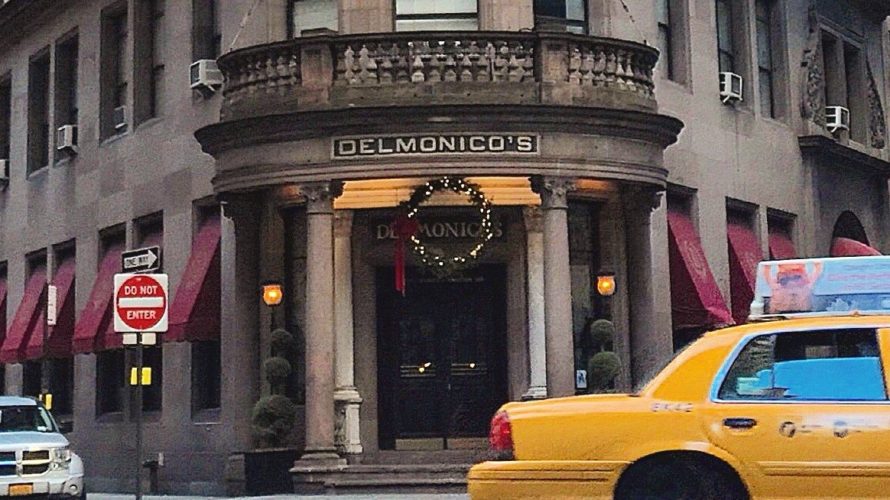By Bryan Ergle
A typical evening for many Americans, and people around the world to be sure… you decide to get dinner at a restaurant. You go and sit down at a fine dining establishment, are handed a menu to look over, and relax while you choose your fare for the meal. Maybe you don’t have too hearty an appetite tonight, so you choose something smaller and less expensive from the menu, saving money and complimenting yourself on your healthy choice, financially.
It likely never crosses your mind, but in the United States, you can trace almost the entire breadth of that experience back to one restaurant: Delmonico’s, in New York City.
Delmonico’s, founded in 1827 as a coffee shop and patisserie, grew just a few years later into what was the first true restaurant in New York City, as opposed to the small cafes and inns serving food, which had been the only options prior. Indeed, it was the first establishment in the US to use the term ‘restaurant’, which surely you find to be ubiquitous today. As well, while, at that time, every dining establishment in the US followed the common practice of serving the same food to everyone, or roughly the equivalent of a modern-day buffet where food was served from a common table, they certainly followed the practice of ‘one price for everyone.’ Delmonico’s was also the first to change that in the US, bringing a French revolution of sorts stateside.
A la carte dining had become popularized as a new trend in France, the revolutionary concept of ordering specific foods that you wanted, and paying only for those, rather than a fixed price regardless of how much – or how little – you might eat. Delmonico’s implemented this, becoming the first establishment in the US to offer a la carte dining. For Americans, used to fixed, single-price meals, how then to keep clarity on what foods were being offered, and at what price?
The answer came shortly thereafter, purportedly in 1834 but likely actually some years later, with another Delmonico’s first, that you take for granted today – the first printed menu in the United States.
Delmonico’s lists of firsts goes on… the first fine-dining restaurant in the US, the first American cookbook offered by a restaurant, and the creation of several well-known dishes: Lobster Newburg, Baked Alaska, Chicken a la Keene (later commonly misnomered as ‘Chicken a la King’), Eggs Benedict, the Delmonico House Salad, and, of course, the Delmonico Steak.
The brothers who founded the restaurant, originally from Switzerland, purchased a farm in Williamsburg, Brooklyn, to grown vegetables largely unknown to Americans at that time, such as eggplant, artichoke, endive, asparagus, and, believe it or not… tomatoes. Yes, the common tomato, which you’d likely thought had been around forever, only really goes back to the early 1800’s in the US. The first references to the plant here note that it was being grown in the Carolinas, and it didn’t become well-known or popular until the early 1900’s, so to grow it for use in a restaurant in New York in the early-to-mid 1800’s was unheard-of. Can you imagine if they hadn’t popularized it as early as they did? What might have changed? What would have become of the famous, but later-born, NYC pizza??
Delmonico’s moved over the years, eventually settling at 56 Beaver Street in the Financial District in downtown Manhattan in 1890, an imposing, eight-story wedge-shaped building, with an entrance flanked by columns that the owners claim were acquired from the ruins of Pompeii. The domineering building is likely the reason that, for a time, the public actually referred to Delmonico’s as ‘The Citadel’, though the later, much softened, public ‘Del’s’ is less intimidating, to say the least. Expanding with new locations to match the restaurant’s booming popularity, but plagued with issues such as fires, the Delmonico’s empire crested and fell, before beginning a series of changes in ownership.
Opening and closing and changing hands at various times, the restaurant has continued, struggling at times, despite its rich legacy. Currently, perhaps, that legacy is in greater danger than ever before.
Closing in March 2020, due to a combination of the Coronavirus outbreak and a simultaneous legal battle over the ownership of the building, Delmonico’s remains closed today, despite hopes to have reopened in late 2021. Currently, a new legal battle has sprung up regarding unpaid rent during the pandemic, the outcome of which may determine the direction for this American legacy.
I, for one, most definitely hope to see the return of Delmonico’s, whether it be triumphant or not. I had the chance, in 2019, to dine there, quite by accident, as it turns out. I was visiting Manhattan with a friend, who had an appointment in the financial district, and needed to keep myself occupied for lunch… thank whatever deity you may choose, I found myself at Delmonico’s, and they had a (small) table available.
I had heard of Delmonico’s at the time, but, for some reason, in the back of my mind I had lumped it together with chintzy, tourist-trap fare, and was not actually overly excited about trying it. I could not have been more wrong. The ambiance was everything you’d hope for from fine dining, from the quiet demeanor to the white tablecloths, and the décor gave every impression of luxury, not of one era, but of all that which the Delmonico name has spanned. The soaring ceiling and chandeliers, the wood and stone speaking to the age of the place, all intertwined with the smell of a fine steak.
Of course, I could not dine at Delmonico’s for the first, and I pray not the only, time, and not get the steak. Having been to many of the best steakhouses, that was still one of the best that I have had. It was cooked and seasoned to perfection, the taste and texture, I can still recall to this day. Thankfully, they even had it as a more common cut, eschewing the oft-found super-thick cut of steak that many places use, but which robs the bon vivant of the enjoyment of a perfectly prepared piece of beef. The sides were even phenomenal, but I couldn’t tell you much about them, as I could barely take my mind off of the steak. It was genuinely that good.
I hope you will get the opportunity to try one of those steaks someday… and if so, please, do so. You never know if that one chance might be the last change. I know I don’t regret a thing about dining there that day. In fact, my only regret about that visit was that I talked myself out of buying a set of their house Delmonico’s steak knives. Shame on me, sometimes I need to learn my own lessons. Here’s to hoping for a better tomorrow – or any tomorrow – for a foundational American institution, Delmonico’s.



